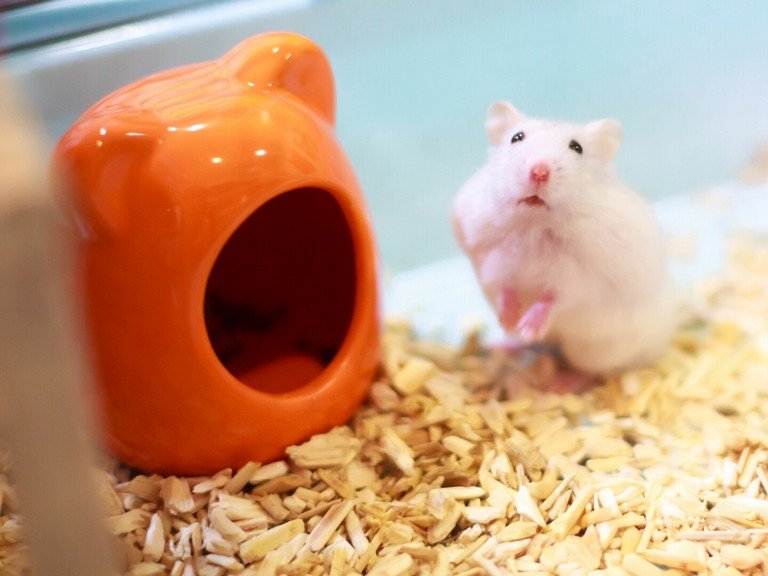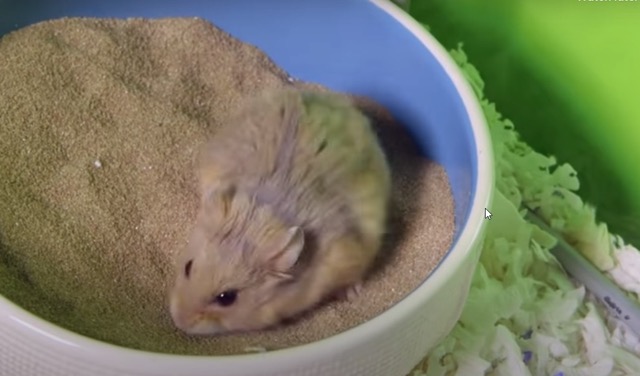Hamster Sand Bath: Everything You Need To Know
How to give a hamster sand bath? Hamsters are naturally clean animals that often groom themselves. Most hamsters keep themselves clean without any assistance from their owners. It is generally advised that if your hamster is unable to clean himself thoroughly, you should not bathe him in water since hamsters can develop a cold fast and die as a result. Hamster sand baths offer an alternate, non-hazardous option for cleaning your hamster.
Hamster Sand Bath

You may be astonished that hamsters clean themselves by rolling in the sand. It is entirely illogical and contradicts all we know about cleanliness. So, what causes this peculiar behavior in rodents? The natural habitat of hamsters is arid and desert-like, where soils are either mixed with sand or entirely replaced by it. The protective oils in a hamster’s fur are essential for keeping them warm and safe from the outdoors.
When this oil accumulates, they roll in the sand, which absorbs it. The sand’s grains serve as an exfoliator to remove accumulated dead skin cells. Usually, the sand falls out of the hamster’s fur, leaving it clean and enticing. In addition to chickens, birds, elephants, dogs, cats, horses, and pigs, numerous other species use the dust bathing method to clean themselves.
What Exactly Is A Hamster Sand Bath
A hamster sand bath box is an enclosed, semi-enclosed structure or receptacle with an aperture. This container is placed in the hamster’s cage and partially filled with specialized sand. A hamster climbs into the sandbox and begins rolling in the sand, known as a “sand bath.”
The natural habitat of wild hamsters is often desert-like regions with abundant sand. These hamsters roll in sand to freshen their coat and alleviate skin problems. Because they dislike water, you will never see a hamster taking a dip in a puddle.
The hamster’s coat’s natural oils are dissolved by water. These oils are protective and promote a healthy coat to keep a hamster warm. Therefore, you will hear that hamsters should never be submerged in water.
As hamster parents, we desire to provide an environment that resembles their natural habitat. A sand bath is one of those items that a hamster would like to have.
Do Hamsters Require Sand Baths

Due to a lack of available room, many hamster owners do not add a sand bath in a hamster’s cage. Hamster sand bathing is part of the grooming routine of a wild hamster. So, there is some disagreement regarding whether a hamster should have a sand bath.
At some point, all hamsters become odorous due to tracking through feces, eating, or scent gland secretions. Our initial inclination is to give our hamster a calming, warm bath. However, hamsters must avoid water baths at all costs.
Alternatively, if necessary, you can use a baby wipe to spot-clean a tiny part of your hamster. Hamsters are meticulous groomers and clean themselves as necessary, and this is when a Hamster sand bath could be helpful.
The Institute of Animal Genetics, Nutrition, and Housing, Division of Animal Housing and Welfare of the Vetsuisse Faculty Bern, published a study on hamsters’ cage behavior. Their research found that grooming was one of the most common behaviors exhibited by hamsters.
The sand bath was used by 46 of the 60 hamsters. Large-cage hamsters spent 12% of their time in a sand bath, while small-cage hamsters spent 19% of their time in a sand bath. As can be seen, most hamsters in the study utilized a sand bath.
How Often Should A Hamster’s Sand Bath Be Replaced
After multiple usages, your hamster’s sand may appear in perfect condition, leading some hamster owners to believe it does not need to be replaced. However, the sand should be replaced once each week during a complete cage cleaning. After all, we wouldn’t want to reuse filthy bathwater repeatedly.
How To Select A Sand Bath For A Hamster

The container you choose for your hamster’s sand bath should be proportionate in size. The sand bath box should be more significant to fit a Syrian hamster. Syrians are the largest species of hamster. Nothing is worse than attempting to do a massive body into a sandbox bath.
Similarly, a dwarf hamster’s wash box will be smaller than a Syrian hamster. The sand bath boxes for dwarf hamsters should be tiny but not so small that the animals cannot move.
Considerations When Selecting A Sand Bath Box
One of the primary concerns of hamster parents is that their hamster’s bath box might not fit inside the cage. If you already have a hamster and a conventional cage, you can put up a sand bath box in a playpen area where the hamsters can wash.
Prospective hamster cages must have sufficient space for a sand bath box, toys, a wheel, food bowl, bedding, and a nesting box if you are in the market for a new hamster.
Can A Sand Bath Be Left In A Hamster Cage
There is a risk that your hamster will urinate in the sand bath box if it is left inside the cage. The sandbox becomes more of a toilet, and you don’t want your hamster rolling around in a soiled sandbox.
How Frequently Should I Give Hamsters Sand Bath

Ideally, you should set a sand bath box in your hamster’s cage daily for a specified period. A hamster may or may not choose to utilize its environment to roll around.
Limiting the time, the sand bath box spends in the cage reduces the likelihood that your hamster will defecate in it. Additionally, there will be less trash and less cleaning. Your hamster will eventually utilize it when supplied.
How Do Sand Baths Work
In the wild, animals frequently use sand and dirt to clean themselves. Sand is inherently abrasive and a suitable alternative to water for animals whose safety would be compromised by bathing in liquid. When your hamster rolls in the sand bath, the resulting abrasion removes extra particles from the fur. The sand itself absorbs extra skin oils and moisture.
Potential Issues Of Hamster Sand Bath
You can offer your hamster sand for a bath, but you cannot force him to utilize it. Most hamsters enjoy sand baths. However, a few may not know what to do or dislike the sand bath. If your hamster does not immediately begin utilizing the sand bath, give him some time to learn how to use it. If you leave the sand bath in your hamster’s cage, check it frequently; some hamsters may mistake it for a toilet.
Sand Bath Or Dust Bath

Dust baths are like sand baths, and the two are frequently confused or substituted. Pay close attention to what you are purchasing: Dust bath products contain finer-grained particles that can irritate your hamster’s respiratory system. Only use the sand bath. Do not give your hamster any product described as a dust bath. Do not use any product not expressly labelled for use on dogs.
Conclusion
Most hamsters can survive without ever having a sand bath, but only if their cage is kept immaculately clean and they have no health or other physical issues that prohibit them from grooming themselves appropriately.
To give your hamster a luxurious bath, you should always verify the sand’s components first, as some include potentially harmful substances. Always provide them plenty of space to burrow, play, and roll around.
